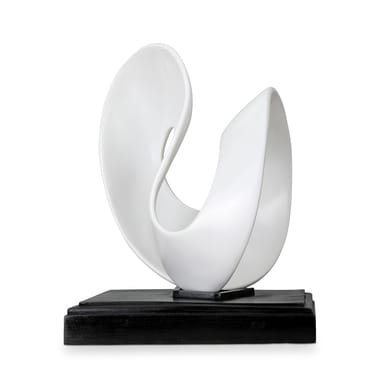
SANKHO CHAUDHURI
Sankho Chaudhuri’s sculptural practice is defined by a restless spirit of experimentation and an unwavering commitment to artistic evolution. Born in Bihar in 1916, he emerged as a foundational figure in modern Indian sculpture, instrumental in breaking free from the constraints of colonial academic realism and opening new pathways for abstraction and innovation. His belief in the continual playfulness of creative exploration fueled a prolific career spanning over six decades, during which he embraced change as essential to artistic vitality.
Trained at Santiniketan under the pioneering sculptor Ramkinkar Baij, Chaudhuri absorbed a modernist ethos but quickly developed a distinct voice that refused stylistic confinement. His embrace of diverse materials, from bronze and wood to concrete and fiberglass, reflects a fearless approach to form and medium. This versatility allowed him to continually redefine his artistic language, ensuring his work remained dynamic and relevant across decades. Chaudhuri’s sculptures balance abstraction with organic vitality. Figures often appear caught in motion, their elongated limbs and flowing contours suggesting dance, flight, or spiritual ascent. Rather than literal depiction, his work channels deeper emotional and archetypal currents, drawing on Indian classical traditions while dialoguing with modernist principles. This synthesis produced a uniquely Indian modernist vocabulary that evokes the essence of human experience, nature, and mythology with rhythmic elegance.
Beyond his studio, Chaudhuri played a pivotal role in shaping India’s post-independence cultural framework. His leadership roles at institutions like the Lalit Kala Akademi and his dedication as an educator profoundly influenced generations of sculptors, inspiring a break from convention and the embrace of artistic freedom. His mentorship helped cultivate a new era of Indian sculpture characterized by diversity and innovation. Sankho Chaudhuri’s legacy extends beyond his tangible sculptures, residing equally in his advocacy for creative liberation and continuous reinvention. His works, exhibited widely across India and internationally, remain enduring symbols of a life devoted to expanding the possibilities of three-dimensional art. Through both form and philosophy, Chaudhuri’s contribution continues to resonate within the ongoing narrative of modern Indian art, embodying a dialogue between tradition, modernity, and the ceaseless pursuit of creative discovery.

